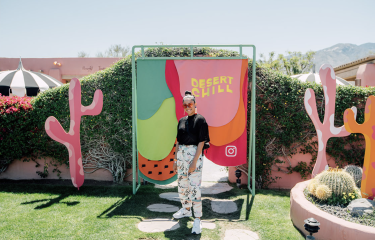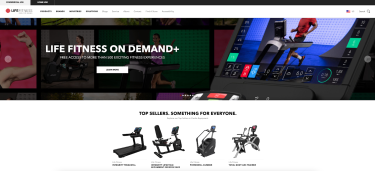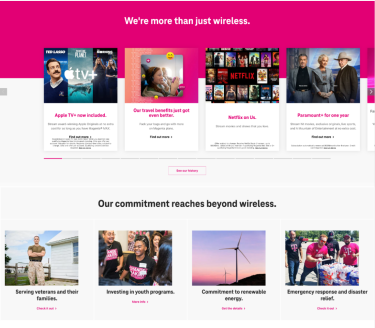What is Brand Experience and Why Does It Matter?

In 2023, e-commerce sales reached $5 trillion dollars – and this trend is expected to continue its upward trajectory, hitting $8 trillion by 2027. With the prominence of online shopping today, the digital world is now the dominant customer environment. This means to be competitive, you need to create a consistent brand experience across every channel — both physical and digital. And that means you’ll have to coordinate some of the experiences that used to happen naturally in-person with strategic digital interactions.
The businesses that can replicate real-life experiences in the digital customer journey with a helpful app, personalized shopping experience, or targeted piece of content will give their brand experience a much-needed boost.
What is brand experience?
Brand experience is the sum of all the sensations, thoughts, feelings, and reactions that individuals have in response to a brand. Brand experience is not specific to a channel or media type. Rather, it’s the result — or the lasting impression — that remains after someone encounters or engages with a brand in any environment. |
Brand experience is ultimately how a customer feels about your brand before, during, and after their interactions with you. This impression can have lasting effects on whether or not they shop with you again and if they would recommend your brand to others. So, it’s important to invest in your brand experience to ensure it’s exactly the one you want to put out into the world.
Brand experience vs. user experience
So how does brand experience differ from user experience (UX)? While both concepts speak to the sensory, cognitive, or behavioral response an individual has in reaction to an experience, there are some nuances.
Unlike brand experience, user experience speaks specifically to a person’s takeaway from their interaction with a brand’s products, services, people, software, or other offerings. For example, customers will have a positive user experience if they receive fast and effective customer service, a frictionless checkout process, or an easy-to-use product.
But here’s where things get confusing. Brands can’t really have one without the other. Positive user experiences also facilitate positive brand experiences. Think about it this way: If someone has a positive user experience every time they visit a brand’s website or app, that also impacts how they view the brand and their experience with it. Conversely, if they have a negative experience (e.g., a coupon code not working at checkout), that’s going to leave a bad taste in their mouth for future interactions. Also keep in mind that user experience should incorporate a consistent brand voice and elements throughout. Otherwise, it’s pretty tough for people to recognize the brand within the experience.
Why is brand experience important?
Brand experience is important because positive experiences facilitate deeper connections, inspire audiences, and ultimately deliver results. Your brand experience can be the deciding factor between whether your brand is chosen or if you lose a sale to a competitor. Because of this, it’s easy to see why companies go out of their way to craft impressive and attention-grabbing brand experiences.`
However, it’s extremely important to create a consistent brand experience as a foundation for flashy and exciting interactions. The most valuable brands in the world know that brand consistency helps to create lasting customer relationships and increases brand recognition.
Some companies make the mistake of focusing all their resources on a few big experiences and ignore the investment in consistency. Some live by consistency and never do anything exciting. Take the middle road and do both to create a great brand experience.
Creating a great brand experience strategy
Creating a great brand experience takes preparation. Before anything can be done, brands need to ensure they have an understanding of their audiences’ wants and needs. Technology like customer data platforms (CDPs) can help brands build comprehensive profiles of their customers so they can glean insights into who they are, how they engage, where they shop, and so on. It is with this intel that brands can create more authentic, meaningful, and memorable experiences that will appeal to their audiences.
1. Engage the senses
While understanding key audiences is absolutely critical, it’s actually more scientific (or should we say sense-itific) than that. At least that’s what Dr. Aradhna Krishna, author and sensory expert, says. In her book, “Customer Sense: How the 5 Senses Influence Buying Behavior,” she talks about how appealing to two or more senses creates more memorable and compelling experiences.
Brands have known about the power of sensory engagement for quite some time. After all, there’s a reason why the “scritch-scratch” of Sharpie markers is audible and why their smell is so potent. And it’s also why some brands opt to do free samples of their products as opposed to just print and digital marketing.
Senses go hand in hand with experience. Sync the two up in a symbiotic relationship, and it’s bound to benefit the brand experience. Luckily for marketers, there are lots of ways to do this, including different types of effective product content. For example, featuring 360° spin photography can give your customers the sense of picking up a product and spinning it around in their hands.
2. Participate in events
Events are a great way for brands to win audience attention and loyalty through sensory appeal and extended exposure. By inserting their brand into an event their target market cares about — or creating one of their own — organizations are creating powerful brand experiences.
3. Participate in popular culture
Although it’s focused on a moment in time, popular culture presents endless opportunities for companies looking to use brand experience to connect with their audiences. This could include participating in the latest TikTok challenge or latching onto the latest season of a hit TV show. Execution requires careful timing and attention to detail, but when done right, it can be pretty powerful.
4. Personalize the message
While brands must find ways to tell their stories, they also need to figure out how to make that story personally relevant to their customers. By prioritizing personalization in their brand experiences, marketers can achieve both of these goals and gain the trust of their customers.
To illustrate this point, think about the level of personalization that modern technologies facilitate for brands. Many consumer brands are using technology like augmented reality (AR) apps to help online shoppers visualize how a product will look on them or in their personal spaces. Location-based technologies help businesses deliver personalized notifications and information to event attendees based on their interests. Website content can be personalized based on how users have engaged with a marketing email or what other pages they’ve browsed. This level of personalization helps brands communicate what they want to share, but in a way that fits into and enhances someone’s personal experience and life.
Examples of brand experience in the digital age
Brand experience isn’t limited to one channel. Think about LEGO, for example. They create immersive, hands-on brand experiences in their stores and theme parks. Their LEGO kits come with instructions that are both age-appropriate and fun to follow. They’ve created movies, books, games, and endless digital content for marketing and consumer consumption.
As you see, brand experience has no walls and most brand experiences have some digital component. Consider nonprofit organizations like the Alzheimer’s Association or American Red Cross. They host tons of in-person donor events to help raise money for their causes. However, they also use digital content like event information, research, e-newsletters, quizzes, and other online resources to keep audiences engaged and informed. Colorful and interactive imagery and video content help the organizations tell their stories online in a way that appeals to their audiences’ senses and personal narratives.
How else does brand experience show up in our daily interactions? Let’s take a look at a few more examples:
During the popular music festival, Coachella, Instagram erected colorful, southwestern scenes just outside the festival grounds for their selfie-loving users. Since Coachella is an established event that many Instagram influencers attend every year, the social media brand took the opportunity to further enhance the experience for their top artists and content creators with an invite-only event. This undercover marketing play delighted their loyal users while also reinforcing the values and voice of the Instagram brand.

McCormick
McCormick is a global leader in the food and beverage industry. They’re not just providing spices and flavorings to their customers; they also offer a meal planner, recipes, and even tips for organizing your spice pantry! They’re helping customers build their own food and beverage experiences with inspirational and aspirational content.

Life Fitness
If you’ve ever used exercise equipment, it’s possible you’ve used a product from Life Fitness. Their products and brands are in gyms, fitness centers, and homes around the world. But it doesn’t stop there. They also offer content for both facility owners and home exercisers, as well as on-demand classes and fitness experiences. It’s more than just a piece of equipment; it’s a complete brand experience.

T-Mobile
Mobile carriers aren’t typically known for being the most-loved companies in the world. You probably have your own horror story about long wait times with customer service, hidden charges, and complex contracts. But T-Mobile is trying to be different. They take a customer-first approach and everything, including their marketing and branding, follows suit. From their website to sponsored events, it’s clear they spend a lot of time thinking about the end-to-end brand experience.

What can harm the brand experience?
According to the 2023 Acquia Customer Experience Trends Report, 79% of consumers are expecting brands to deliver a consistent message and appearance across all the digital platforms they interact with them on. Failing to meet that expectation can seriously damage a brand’s reputation. Below are some other common ways that brands fall short when it comes to creating positive customer experiences.
Overlooking personalization opportunities
Brands can’t get away with displaying the same generic “Welcome!” content to shoppers who’ve been coming back for years. Your customers aren’t just faceless numbers, so don’t treat them as such. Most companies have access to more data than ever before and still don’t use it to personalize interactions with users. Our trends report found that only 43% of marketers “slightly agree” that their organization knows how to use customer data to create digital experiences.
By learning how to access user data in real time and learn about their customers, brands can create experiences for the best opportunities. When they know how customers interact with them, companies can produce meaningful content that’s impactful.
Being too invasive
You know how Facebook will show you ads for an item you were just looking at on Amazon a few seconds ago? It’s a bit unsettling, right? That’s personalization at an invasive pace. Instead of encouraging confidence and trust, it opens the door for suspicion.
Target has an infamous personalization overstep story. The retailer used individual browsing data to determine if a shopper was likely to be pregnant in order to email them promotions for maternity items. This backfired when the company emailed the father of a teenager and exposed her pregnancy to her parents before she had told them herself.
It’s vital to understand when to step back and only approach customers when they’ve given you permission. If brands are too invasive, people won’t trust them, and they’ll shop at another company. Only 58% of consumers say they like it when a brand seems to know their interests and preferences, according to our report. But an even smaller percentage (17%) believe the data they share with an organization is secure. So while consumers will exchange personal details for better experiences, they have legitimate concerns.
Being unresponsive
These days, when someone doesn’t get a quick response to a message, they’ll assume a brand is ignoring them. People are used to immediate interactions on platforms like Twitter and live chatbots. Across all channels, your business needs to offer timely, relevant messaging and customer service.
Social media is widely regarded as an “always-on” channel, and customers expect brands on these platforms to respond quickly. Customers also expect proactive solutions, not a runaround; they don’t want to be pointed to complex policies or webpages. Earning and keeping customer trust by being responsive is a 24/7 job for brands.
Ignoring accessibility
One of the most fundamental components of getting customer experience (CX) right is ensuring that the experiences you offer are available and accessible to everyone. There are currently over 1.3 billion people worldwide – or 16% of the population – experiencing a significant disability. Brands need to make websites easy to use for people with visual, auditory, neurological, language, or physical impairments. Brands that ignore proper accommodations for things such as brightness, coloring, and image descriptions are basically communicating that they don’t care about meeting a potential customer’s needs and that some consumers matter less than others.
Digital asset management and brand experience
Organizations that want to fuel strong brand experiences for their audiences need to have the right elements in place. They need digital assets, like imagery, videos, and marketing collateral to support their efforts and ensure their brand images and values are upheld across all channels and environments.
That kind of omnichannel brand consistency requires the right digital asset management (DAM) software. With a DAM system to store, manage, and publish your brand assets, you can create a seamless and positive brand experience at each and every touchpoint.
Request a demo or watch one on-demand today to learn more about how Acquia DAM (Widen) can help you create relevant and memorable brand experiences that build trust and drive sales.
Note: This article was originally published in January 2020 and has been updated to remain current.


